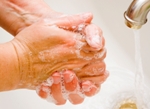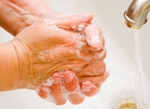
Nanomaterials: The Unseen Enemies
A study by the University of Massachusetts Lowell noted latex and nitrile gloves have thinner areas (intrinsic voids) where nanoparticles tend to accumulate.
When the outside environmental skin hazards are visible ones, such as a mechanic's contact with grease, it is obvious when the contaminant needs to be removed. When the environmental skin hazards are not visible to the eye--for example, working with nanomaterials--it is not obvious when the skin's natural barrier has been compromised.
A new word in the vocabularies of many safety managers and industrial hygienists, "nanomaterial" defines a particle between 1 and 100 nanometers (nm) and can be composed of many different base materials (carbon, silicon, and metals such as gold, cadmium, and selenium).1 While respiration of such nanoparticles is of great concern also, this article briefly addresses hand protection from these "sight unseen" contaminants.
Choose the Right Glove
Industry publications recommend PPE (gloves) when working with nanoparticles for this reason: "the ability of nanoparticles to penetrate the skin is uncertain at this point, gloves should be worn when handling particulate and solutions containing particles."2 Standard guidelines in choosing the right glove holds true when working with nanoparticles, such as good chemical resistance against the materials being handled and proper fit. Some suggest wearing two pairs of gloves. 2
A study by the University of Massachusetts Lowell noted a lack of standardized test methods to test the efficacy of protective gloves against nanomaterials. This study also noted latex and nitrile gloves have thinner areas (intrinsic voids) where nanoparticles tend to accumulate. These thinner areas might be vulnerable to penetration by nanoparticles if used under unfavorable conditions, such as stretching (elongating) the gloves, extended wear time, or severe tear situations.3
NIOSH has identified engineering controls and personal protective equipment (PPE) as one of 10 critical topic areas as guides to address gaps in knowledge, strategies development, and providing recommendations in regard to nanotechnology. This includes the evaluation and improvement of current PPE. Until more data are available, the use of good industrial hygiene practices, including providing both PPE and hand washing facilities, should be continued.4
Ensure Proper Hand Washing
 One need only look at local and world news to hear current statistics of the H1N1 (swine flu) outbreak, amateur and professional sport participants undergoing treatment (often life changing, such as amputation) for MRSA, and other "invisible" enemies attacking our epidermis. Luckily, our best defense is just a wash basin away. According to Erica Odom of CDC, "Hand hygiene or hand washing is the single most important thing that you can do to help prevent the spread of infection and to stay healthy and well."5
One need only look at local and world news to hear current statistics of the H1N1 (swine flu) outbreak, amateur and professional sport participants undergoing treatment (often life changing, such as amputation) for MRSA, and other "invisible" enemies attacking our epidermis. Luckily, our best defense is just a wash basin away. According to Erica Odom of CDC, "Hand hygiene or hand washing is the single most important thing that you can do to help prevent the spread of infection and to stay healthy and well."5
Most of us consider hand washing to be a routine, automatic action and never give much thought or attention to the task. Reviewing the steps ourselves, and educating employees to those steps, takes only moments and can prevent many illnesses leading to days away from the job:
1. Apply hand cleanser to hands.
2. Wet hands with tepid (moderately warm) water and work cleanser into a lather.
3. Vigorously rub together all surfaces of lathered hands, including fingers, nails, and around cuticles, for at least 15 seconds. This is the most important step: The friction, in combination with the cleanser's surfactant, will help to remove dirt and microorganisms.
4. Rinse hands thoroughly under running water to remove all lather.
5. Dry hands thoroughly with a paper towel. Leaving soap residue on the skin and incomplete drying contribute to dermatitis. Turn faucet off with towel.
How long is 15 seconds? As taught to young children, it's the time it takes to sing the "ABC Song" or "Happy Birthday." Teens are taught to judge the time by the chorus of their favorite song, repeating it twice.
Often, the use of tepid--not hot--water is questioned. Hot water can be too uncomfortable to the skin to facilitate proper washing. Warm water is better tolerated by the skin and increases the time spent in the cleansing experience.
Use the Right Hand Cleanser
In industrial settings, the type of hand cleaner chosen is critically important to skin health. Common cleaners--such as paint thinner, abrasive powders, and solvent- or d’limonene-based hand cleaners, so-called "orange" hand soaps--should be avoided. NIOSH's Current Intelligence Bulletin 48 on Organic Solvent Neurotoxicity finds that certain chemicals--such as xylene, found in common paint thinner--can be absorbed into the bloodstream within 15 minutes of skin contact.6 Borax- and pumice-based abrasive hand cleaners strip away the skin's natural barrier, the stratum corneum, increasing susceptibility to rashes and dermatitis. Petroleum-based solvents may cause a defatting action on the skin, while hand cleaners that contain orange d-limonene solvent may cause allergic reactions and promote dry skin conditions.
Additional factors that contribute to dry skin conditions and dermatological issues are: cleaning the hands with a product too aggressive for the hazard being removed, too frequent hand washing, inadequate rinsing of the product from the hands, and use of abrasive grit (i.e., pumice vs. soft scrubbers).
A word about anti-microbial cleansers: There is evidence that the overuse of anti-microbial products is aiding in the development of bacteria that are increasingly resistant to the cleansers' germ-killing properties. Frequent and thorough hand washing with a non anti-bacterial hand cleanser is sufficient in most circumstances.
When water is not available, the use of alcohol-based hand sanitizers is suggested. Remember, however, that hand sanitizers are not hand cleaners! While the alcohol will reduce the germs on the hands, removing the contaminant is also necessary. Non-alcohol sanitizers based on quats have yet to receive FDA sanctioning.
Continue Skin Care After Work
Frequent skin contact with hazardous substances requires a final step: an effective after-work cream that helps the skin heal and regenerate. Most people are familiar with the benefits of using a good skin moisturizer to replace lost moisture and skin lipids, especially during the winter months, when the combination of lower outdoor humidity and heated indoor air results in additional moisture loss.
Because warm air is capable of holding more moisture than cold air, heated indoor air acts like a sponge, absorbing moisture from everything it touches, including human skin. In these conditions, the use of a harsh hand cleaner can severely aggravate skin irritation, and frequent use of even the most skin-friendly hand cleaner can leave the skin dry. Be sure to choose a moisturizing and conditioning product formulated for workplace conditions. Most conditioning products sold at retail stores can contain about 90 percent water. A product containing 15 to 30 percent lipids (fat derivatives) is preferable for occupationally stressed skin.
Education Promotes Prevention
In order to prevent skin damage, it is vital to educate workers about the importance of maintaining healthy skin and to inform them that proper skin care can prevent physician visits and lost work time. Workers should know about the potential hazards of the substances they work with and how those substances can affect their skin. Education on the safe and effective removal of potentially harmful substances from the hands, both during and after the workday, is also critical.
References
1. www.ehs.psu.edu/occhealth/nanomaterials.cfm (2004)
2. Journal of Chemical Health & Safety, January/February 2009
3. "Dermal and Respiratory Protection in Handling Nanomaterials at the Center for High-Rate Nanomanufacturing (CHN)," Kwangseog Ahn and Michael J. Ellenbecker, Toxics Use reduction Institute, Department of Work Environment, The University of Massachusetts Lowell, 2006.
4. Approaches to Safe Nanotechnology, Department of Health and Human Services, Centers for Disease Control and Prevention, National Institute for Occupational Safety and Health, Publication No. 2009-125, March 2009.
5. CDC Podcast, "Put Your Hands Together," October 2008, www.cdc.gov
6. www.cdc.gov/niosh/87104_48.html DHHS (NIOSH) Publication No. 87-104; Current Intelligence Bulletin 48: Organic Solvent Neurotoxicity; March 31, 1987.
About the Author
Armand A. Coppotelli is the Senior Technical Trainer at Deb USA, Inc., a global occupational skin care company. He holds a master's degree in Environmental Health/Industrial Hygiene from Temple University in Philadelphia. Prior to joining Deb, he served as an industrial hygienist and compliance officer during the late 1970s and early 1980s for the U.S. Department of Labor-OSHA, Region III in Philadelphia. For over 30 years, he has conducted training and workshops for numerous organizations and worked with leading occupational skin researchers, dermatologists, and corporate medical & safety directors. His expertise is in occupational skin care, specifically the prevention of occupational skin disease and work-related eczema, as well as the implementation of proper hand hygiene programs. You can also frequently find articles written or co-authored by him in key industry publications. To learn more about occupational dermatitis prevention and Deb Group’s complete line of skin cleansers, creams, and dispensers, visit http://www.debgroup.com/us.